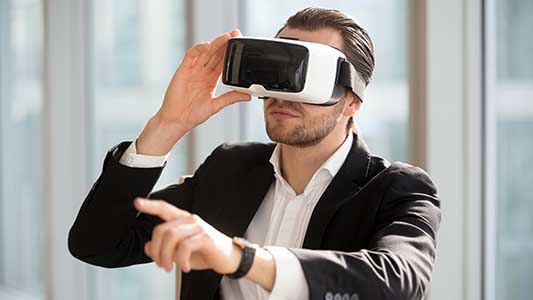Virtual Reality (VR) technology is transforming the way we experience the world. From gaming and entertainment to education and healthcare, VR has become an increasingly popular tool for simulating experiences that would otherwise be impossible. In this article, we will explore the basics of virtual reality, its history, how it works, and its various applications.
Introduction to Virtual Reality
Virtual Reality is a technology that simulates a realistic and immersive environment that can be experienced through the use of specialized devices such as headsets or gloves. It is an interactive and computer-generated environment that can be designed to replicate a real-life situation or create an entirely new world.
History of Virtual Reality
The idea of virtual reality dates back to the 1960s when Ivan Sutherland developed the first head-mounted display (HMD) for computer graphics. However, it was not until the 1990s that VR technology became commercially available. Since then, VR has continued to evolve and has become an essential tool in various industries.
How Does Virtual Reality Work?
Virtual reality technology works by creating a digital environment that mimics the physical world. It uses a combination of hardware and software to create an immersive and interactive experience. The hardware components include a headset or display, hand controllers, and sensors that track the user’s movements. The software components include the virtual environment and the applications that run on it.
Types of Virtual Reality
There are three main types of virtual reality: non-immersive, semi-immersive, and fully immersive.
Non-Immersive VR
Non-immersive VR is the most basic form of VR technology. It usually involves a computer screen or a projection on a wall. The user interacts with the virtual environment using a keyboard, mouse, or gamepad.
Semi-Immersive VR
Semi-immersive VR provides a more immersive experience than non-immersive VR. It typically involves a large screen or a projection that surrounds the user, providing a 180-degree view. The user interacts with the environment using specialized controllers or handheld devices.
Fully Immersive VR
Fully immersive VR provides the most realistic and immersive experience. It typically involves a headset or HMD that completely covers the user’s eyes, providing a 360-degree view of the virtual environment. The user interacts with the environment using specialized controllers or gloves that track their movements.
Virtual Reality Applications
Virtual reality has numerous applications across various industries. Some of the most common applications include:
Gaming
Gaming is one of the most popular applications of VR technology. It allows players to immerse themselves in a virtual world and interact with it in real-time.
Education and Training
VR technology is increasingly being used in education and training to simulate real-life scenarios and provide hands-on experience. This is particularly useful in fields such as medicine, engineering, and aviation.
Healthcare
VR technology is also being used in healthcare to treat various conditions such as phobias, anxiety, and post-traumatic stress disorder (PTSD). It is also used in pain management and physical therapy.
Real Estate
VR technology is being used in the real estate industry to create virtual tours of properties. This allows potential buyers to view properties and get a feel for the space without having to physically visit it.
Military and Defense
VR technology is also used in military and defense to simulate training scenarios and provide soldiers with a realistic environment to practice their skills.
Challenges and Limitations of Virtual Reality
While VR technology has numerous benefits, it also faces several challenges and limitations. Some of these include:
Cost
VR technology can be expensive, particularly for high-end devices. This can make it inaccessible for some users and industries.
Motion Sickness
Some users may experience motion sickness or discomfort when using VR devices. This can limit the amount of time they can spend in a virtual environment.
Limited Field of View
While fully immersive VR provides a 360-degree view, it still has limitations in terms of field of view. This can limit the user’s ability to interact with the environment and can reduce the sense of immersion.
Limited Interaction
While VR technology allows for a high level of interaction, it still has limitations in terms of tactile feedback and physical interaction with the virtual environment.
Future of Virtual Reality
The future of VR technology looks promising, with continued advancements in hardware and software. As the technology becomes more affordable and accessible, it is likely to become increasingly integrated into our daily lives. Some experts predict that VR technology may even replace traditional screens and displays in the future.
Conclusion
Virtual reality is a rapidly evolving technology that has numerous applications across various industries. While it faces several challenges and limitations, the benefits it provides are undeniable. As VR technology continues to advance, we can expect to see more innovative applications and uses in the future.












